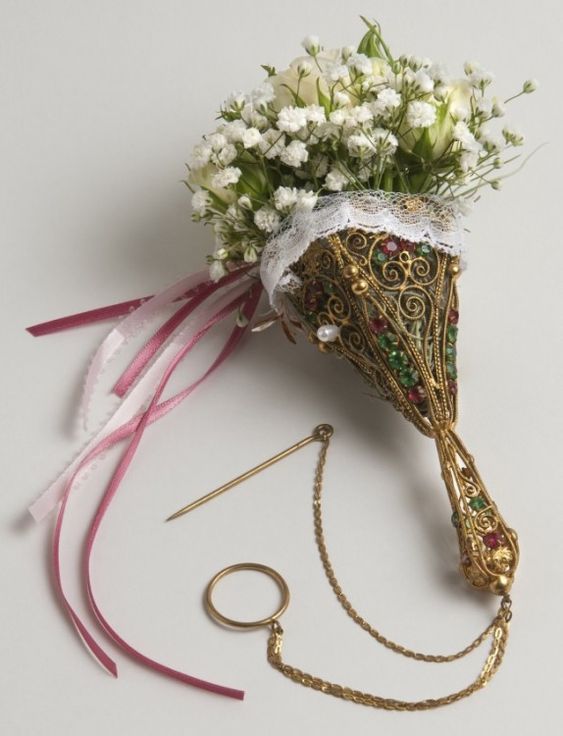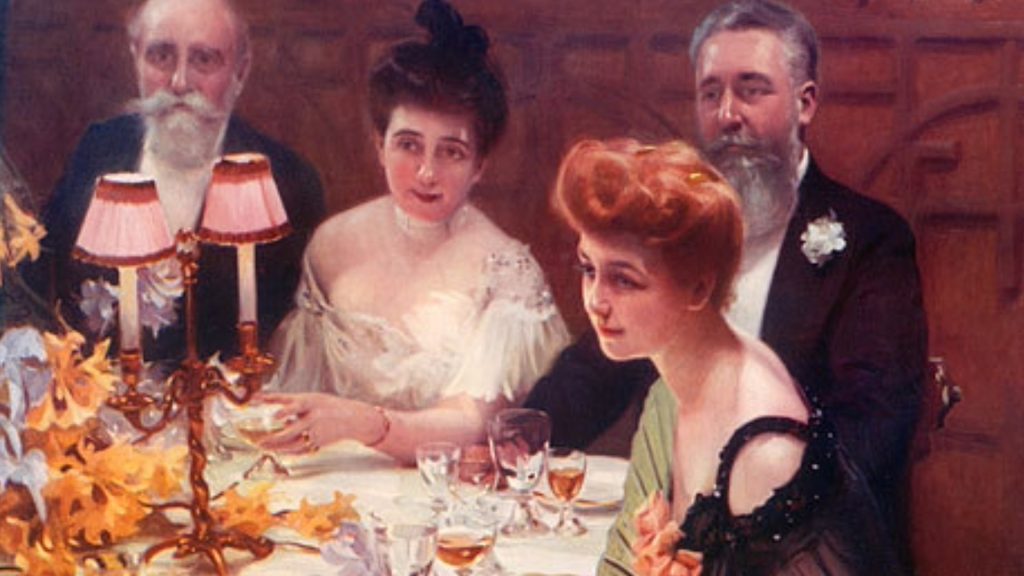If you grew up with a mother telling you to keep your elbows off the table and not to wear white after Labor Day, then you know that etiquette rules change over time. We’ve gotten a lot more relaxed about some etiquette rules and implemented new ones as times changed. When we look back at prior etiquette rules from our modern vantage point, it is easy to chuckle. Let’s look at some of the strange and absurd things people of the past had to do to be considered well-mannered.
Bring Your Own Knife and Fork
In Tudor England, for example, guests to lavish dinner banquets were expected to bring their own utensils.

In Tudor England, for example, guests to lavish dinner banquets were expected to bring their own utensils. Tables were set with fine dishes … just not spoons and knives and forks. To show up without your own spoon was considered rude, so guests were careful to carry their own cutlery lest they offend their host.
Dressing to Impress When Flying the Friendly Skies
Travelers today want to be as comfortable as possible when they fly. It is not uncommon to see passengers on your next flight wearing sweatpants, flip flops, leggings, athletic shorts, tank tops, and t-shirts. You never know when a flight will be delayed, or you’ll have to wait on the tarmac for hours. Who wants to sit in tight, restrictive, binding clothes?

When air travel first took off, passengers were expected to dress up to fly. Men wore suits and neckties. Women wore nice dresses and heels. The passengers looked like they were heading out to a fancy dinner. There were strict dress codes on some airlines. To board a plane in one’s casual, everyday attire was offensive and in poor taste. Things didn’t loosen up until the late 1980s.
Tussie-Mussies: How the Victorians Used Coded Flowers to Send Secret Messages
Courting etiquette was quite complex in the Victorian Era. They were restrictive and formal and prevented couples from spending time together getting to know each other. The Victorian Era placed a high value on modesty, purity, and propriety, meaning that the interaction between young couples was closely monitored by their parents to ensure that things didn’t get too familiar until the couple could say “I do.”

Smitten couples could share their feelings by sending each other tussie-mussies, small flower bouquets. Every flower, herb, and weed growing in English gardens was linked to specific verses so a sender could make a tussie-mussie with certain flowers and the receiver would be reminded of those verses and their messages. Even the size, quantity, and color of the flowers held meaning.
Say “Cheese!” Actually, Don’t
Have you ever flipped through really old family photo albums and wondered why your ancestors never smiled? It’s not that they hated their lives and were terribly unhappy. It wasn’t that people of the past lacked a sense of humor. On the contrary, they were probably a fun-loving bunch. This just didn’t come through in photographs. That was intentional.

Etiquette of the day stated that people should have a serious expression when being photographed. For women, smiling and showing their teeth was considered flirtatious, obscene, and suggestive. For both men and women, big smiles were seen as a sign of insanity and mental instability. Folks back then understood that their photographs would serve as a record of the past. They didn’t want their grandchildren and great-grandchildren to think grandma was a floozy and grandpa was nuts.
Putting on Gloves in Public Was a Big No-No
Throughout the 1800s, proper ladies never appeared in public with their hands bare. Even in the hottest weather, social etiquette of the time stated that ladies must wear gloves covering their hands. They were to keep the gloves on even when eating, riding, dancing, or just casually strolling through the gardens of their own homes. After all, one never knew when unexpected guests would stop by.

The glimpse of an ungloved hand in public was shocking, but there was an even bigger faux pas to worry about. According to social rules, it was disgraceful and a sign of poor breeding for a lady to put her gloves on in public. Etiquette books claimed that donning gloves on the street, in full view of strangers, was akin to putting on one’s corset or pantaloons in public. Books and magazine articles often advise women to check and double check their appearances before stepping out their front door to make sure they weren’t missing a significant article of clothing, like a pair of gloves.
Men Had to Follow Strict Etiquette Rules Before They Could Kill Each Other
Throughout the 18th and 19th centuries, men often settled their differences with duels. It was ill-refined and barbaric to simply pull out a gun and start shooting at one’s foe. Instead, there were strict etiquette rules surrounding duels. First, there had to be an honorable reason for the duel. Duels were not fought over petty theft or property damage. Duels were fought to defend one’s honor, dignity, or reputation after an insult, slander, or if someone believed their code of honor was violated.

The victim of the insult had to present a written challenge to their intended opponent which outlined the offense and stated how the issue could be satisfied. The men’s friends, or seconds, attempted to resolve the situation without bloodshed and a duel could be called off if the offender apologized. Everyone involved in the duel was expected to follow a code of silence. The first rule of duels: you don’t talk about duels.
Victorian Etiquette Dictated How Long a Widow Could Greive
During the Victorian era, complex etiquette rules were in place to maintained proper decorum throughout the mourning period. Etiquette determined how long a person could mourn. Depending on one’s relationship to the deceased, the mourning period could last a few months up a few years. During that time, a person passed through deep mourning, second mourning, and half-mourning. There were, of course, different rules and restrictions that applied to each one.

A widow had to wear all black dresses, veils, gloves, and hats. The heavy black veils that widows were required to wear completely covered their faces when they were in the deep mourning phase and were incrementally lifted higher as she entered a new phase of mourning. Widows in deep mourning could not attend parties or social events, nor could she host a gathering at her home. The only place she could go was church.
Well-Mannered Renaissance Men Wore Decorative Crotch Covers
Codpieces, decorative crotch covers, were worn by well-mannered men of the 15th and 16th centuries. Codpieces were initially designed to connect the ends of men’s hose, which were two separate pieces in those days. It didn’t much matter what they looked like because men’s long tunics covered them. But when tunics became much shorter, the codpieces were exposed. Instead of being scandalized, fashionable men of the era seized the opportunity to play it up.

Men wore stuffed, padded codpieces to enhance the size of their crotch area and appear more masculine and virile. Jewels, rich fabrics, and expensive ribbons were used to decorate the codpieces. Although they were intended to be flashy and to flaunt one’s manhood, there were clear etiquette rules regarding codpieces. Ladies were required to keep their eyes focused on the man’s face rather than his other assets. It was shocking and vulgar for a lady to stare at a gentleman’s codpiece.
Edwardian Dinner Parties Were Rife with Rules
Fancy dinner parties in the Edwardian era were not the lively, joyous affairs that we see on Downton Abbey. Guests and hosts alike must follow the rigid rules of etiquette that sucked the fun right out of these parties. The host and hostess arranged the seating of their guests to encourage a compatible mix and guests were required to find the place card bearing their name and sit in their assigned seat.

Upon sitting, guests should sit in silence until the servants brought the food and the host signaled that talking was permitted. Women were expected to be demure and soft-spoken, therefore men at the table could only address the woman seated to his right. If he struck up a conversation with a lady sitting anywhere else around the table, she may have to raise her voice to be heard, which was a social no-no.
Etiquette Handbooks Determined Who Brides Could Have as Bridesmaids
When a woman gets engaged today, she typically invites her besties, her sisters, and maybe her soon-to-be sisters-in-law to serve as her bridesmaids. According to Victorian bridal etiquette handbooks, this was not the case a century or more ago. In those days, the social rules and customs dictated who could stand up for a bride at her wedding. And it was all about looks.

First, a bridesmaid had to be a young woman. An older sister, especially if she had a wrinkle or two, was not a suitable bridesmaid. The bride selected a group of girls to be her bridesmaids who closely resembled her. All the bridesmaids should be the same height, the same age, and have the same hair color. For the wedding, they all wore identical dresses and styled their hair the same way.
Mind Where You Are Standing
Etiquette rules of the past were quite specific about where a man should stand in relation to a woman … and those rules changed, depending on the situation. For example, when a man and woman walked down a sidewalk, etiquette said that the man should walk on the side closest to the street. This was so that the man could protect the woman from dangers, like a leering passerby or the splash from a puddle.

When seated for a formal dinner, the woman should sit on the man’s right side. This custom stems back to medieval times when men kept their swords on their left hip for easy access. When going down a staircase, the man should lead the way and be prepared to catch the woman should she stumble, but the woman should climb the staircase ahead of the man so he could block her ascend from prying eyes, thus maintaining her modesty.
Sing if You Must
All properly brought up young ladies in Victorian times were taught to sing and devoted time to learning several songs. During parties and social gatherings, it was common to ask a young lady or two to entertain the guests by singing a few songs. It didn’t matter if she had the voice of Beyonce or Rosanne Barr, this was an offer she couldn’t refuse.

Imagine the horrors of a shy introvert being asked to perform a solo in front of a group of people. In Victorian times, no one gave a thought to a girl’s anxiety and stage fright. It was terribly rude, a sign of poor parenting, and an embarrassment to her father if she refused. On the plus side, she didn’t have to worry about sneers and snickers. The etiquette rules for the guests stated that they had to politely listen and respond with praise no matter how awful the girl’s singing voice was.
The Evolving Etiquette Rules
The etiquette rules of the past may seem silly by modern standards, but they were extremely important at the time. They both reflected and reinforced the values, social norms, and gender expectations of their time. Learning about the odd etiquette rules of the past offers us a glimpse into the lives of our ancestors.

Life a century or two ago was, at least for the wealthier members of society, much more formal than it is today. As archaic as they are when viewed through our modern lens, these historical etiquette rules upheld the social fabric of the past.






